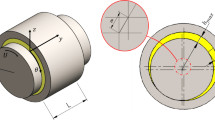Abstract
Synthetic lubricants and additives have seen many major improvements in recent years. However, very little is known about the performance peculiarities of these new lubricants in actual machines. To fill this gap, a new full-scale hydro-dynamic journal bearing test rig has been constructed to evaluate the behavior of conventional and new bearing designs, synthetic lubricants and variations in operating parameters. This test rig’s bearing has diameter 180 mm with measuring capabilities including continuous film thickness and film pressure as well as temperature. The new machine was used to compare a number of synthetic lubricants to mineral based lubricants, finding that performance of the synthetic lubricants was superior to their mineral based counterparts of much higher viscosity grade. These tests showed that high viscosity index (VI) synthetic lubricants had higher viscosity in the region of maximum pressure and lower viscosity elsewhere in the bearing than similar mineral based lubricants. This reduction in viscosity in low pressure zones was found to produce a measurable reduction in friction and power loss in the bearing system. This paper provides comparative performance results of several formulations of current and future turbine oils from measurements of losses, oil film thickness, and temperature under a range of operating parameters. Lubricants tested include ISO VG68 and VG32 mineral based turbine oils (VG68 and VG32), ISO VG32 synthetic ester based oil (SE32), two ISO VG22 synthetic ester based oils (SE22 and SV22), and ISO VG15 synthetic ester based oil (SE15). It was found that SE32 and VG68 provided similar performance at lower speeds while SV22 provided similar performance to VG68 at the highest speed. Likewise, SE22 and SV22 provided similar performance to VG32 at low speeds while SE15 provided similar performance to VG32 at medium to higher speeds. Generally, the results demonstrate the potential for replacing mineral based lubricants with high performance synthetic lubricants of significantly lower viscosity grade without sacrificing bearing safety.










Similar content being viewed by others
References
Gagnon, L.: Civilisation and energy payback. Energy Policy 36, 3317–3322 (2008)
Boehringer, R.H., Neff, F.: Lubrication of hydroelectric turbine thrust bearings with a diester-based synthetic lubricant. J. Synth. Lubr. 6, 311–323 (1990)
Swanson, E.E., Kirk, R.G., Mondy, R.E.: An examination and comparison of the maximum film temperature in a journal bearing for 13 synthetic, mineral, and viscosity index enhanced oils. In: International Fuels and Lubricants Meeting and Exposition, pp. 137–145, SAE, San Francisco (1992)
Dmochowski, W., Webster, M.N.: The effect of lubricant viscosity-temperature characteristics on the performance of plain journal bearings. In: World Tribology Congress III, Washington DC, USA (2005)
Vijayaraghavan, D., Brewe, D.E.: Effect of rate of viscosity variation on the performance of journal bearings. J. Tribol. 120, 1–7 (1998)
Ferguson, J.H., Yuan, J.H., Medley, J.B.: Spring-supported thrust bearings for hydroelectric generators: influence of oil viscosity on power loss. In: Dowson, D. (ed.) Leeds-Lyon Symposium on Tribology, Tribology Series, pp. 187–194. Elsevier, London (1997)
Glavatskih, S.B., Decamillo, S.: Influence of oil viscosity grade on thrust pad bearing operation. Proc. Inst. Mech. Eng. 218, 401–412 (2004)
Brockwell, K., Dmochowski, W., DeCamillo, S.: An investigation of the steady-state performance of a pivoted shoe journal bearing with ISO VG 32 and VG 68 oils. Tribol. Trans. 47, 480–488 (2004)
New, N.H., Schmaus, R.H.: Performance of adipate diester synthetic lubricants in the hydrodynamic regime. In: proceedings of the 12th Turbomachinery Symposium, pp. 139–144. College Station, TX, USA (1983)
Glavatskih, S.B., Larsson, R.: Performance of synthetic oils in the hydrodynamic regime - 1 experimental. J. Synth. Lubr. 20, 15–24 (2003)
McCarthy, D.M.C., Glavatskih, S.B., Byheden, A.: Influence of oil type on the performance characteristics of a two-axial groove journal bearing. Lubr. Sci. 21, 366–377 (2009)
Stohr, T., Eisenberg, B., Muller, M.: A new generation of high performance viscosity modifiers based on comb polymers. J. Fuels Lubr. 1, 1511–1516 (2009)
Kuznetsov, E., Glavatskih, S.B.: On power loss reduction in hydrodynamic journal bearings. Tribol. Int. (To be submitted)
Martin, F.A.: Oil flow in plain steadily loaded journal bearings: realistic predictions using rapid techniques. Proc. Inst. Mech. Eng. J 212, 413–425 (1998)
Acknowledgments
The research presented in this paper has been carried out as part of a project in conjunction with the Swedish Hydropower Center–SVC. SVC has been established by the Swedish Energy Agency, Elforsk and Svenska Kraftnät in partnership with academic institutions. Additional acknowledgment is given to Statoil Lubricants and Evonik RohMax Additives GmbH for material support.
Author information
Authors and Affiliations
Corresponding author
Rights and permissions
About this article
Cite this article
Simmons, G.F., Glavatskih, S.B. Synthetic Lubricants in Hydrodynamic Journal Bearings: Experimental Results. Tribol Lett 42, 109–115 (2011). https://doi.org/10.1007/s11249-011-9753-2
Received:
Accepted:
Published:
Issue Date:
DOI: https://doi.org/10.1007/s11249-011-9753-2




